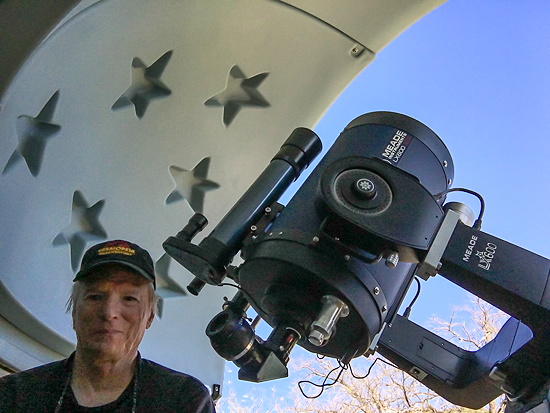Perigee Full Moon, Venus,
Comet C/2019 Y4 (ATLAS), M53
Posted: 10 April 2020
Cloudy skies returned on Sunday, 5 April 2020, and continued until Thursday, 9 April.
Tuesday evening, 7 April, I got this photo of the "Perigee Moon" (220978 miles, angular diameter 33.6') through a hole in the clouds. Taken with the D850 DSLR (f/11, 1/640sec, ISO 200, FL 600mm, handheld, cropped).

Click or tap on image for larger version
|
Open: Thursday. 9 April 2020, 1613 MST Temperature: 86°F |
Session: 1453 Conditions: Clear, breezy |
Equipment:
12" f/8 LX600 w/StarLock
2" 24mm UWA eyepiece
2" 9mm 100° eyepiece
1.25" 15mm eyepiece
4X Powermate
Camera:
D850 DSLR
iPhone 11 Pro Max
I went to the observatory about two and half hours before sunset so that I could participate in an International Dark-Sky Association (IDA) Dark Sky Advocates video teleconference from inside the observatory. This is the view that participants would see:

1630 MST: LX600 ON, StarLock OFF, High Precision OFF.
Viewed Venus, 102X and 271X.
1700-1746 MST: IDA video teleconference. I briefly showed them a view of Venus through the eyepiece (271X) using the iPad Pro that I was using to participate in the teleconference.
I mounted the D850 DSLR at prime focus + Tele Vue 4X Powermate. Did a video recording of Venus (1080p, 60fps, 1/800sec, ISO 640, White Balance Auto). This is a stack of 1212 video frames using the Mac app Lynkeos.

Did some more Venus observing, 102X and 271X. I added a Variable Polarizing Filter (VPF) to reduce the glare from the bright planet. That resulted in a very nice view of Venus. This is a handheld iPhone 11 Pro Max afocal 271X + VPF photo of Venus taken with the iOS app NightCap Camera (ISO 160, 1/350sec, 2X lens).

1851 MST: sunset.
1903 MST: last look at Venus, 102X.
1908 MST: SYNCed the AutoStar on the star Capella. Then tweaked the alignments of the two finderscopes.
1926 MST: I noticed that the star Betelgeuse in the constellation of Orion is looking more like its normal appearance in magnitude. Welcome back Betelgeuse.
1946 MST: mounted the D850 DSLR at prime focus to image Comet C/2019 Y4 (ATLAS). There have been reports that the comet's nucleus has disintegrated. Focused on the star Capella using the Meade Bahtinov Mask and locked the 12" primary mirror.
2005 MST: Meade Stella Wi-Fi Adapter ON.
Used SkySafari 6 Pro on the iPhone 11 Pro Max to GOTO Comet C/2019 Y4 (ATLAS).
2007 MST: StarLock ON.
This is the comet, StarLock autoguided, 1 minute, ISO 6400, WB 5560K.

Compare this session's image with the image I took on 1 April using the same exposure settings and scale.

Yep, expectations for Comet C/2019 Y4 (ATLAS) becoming a naked eye comet have fizzled.
2013 MST: Wi-Fi OFF.
2019 MST: viewed Comet C/2019 Y4 (ATLAS), 102X and 271X. No nucleus visible. Only a diffuse and faint coma were visible.
2031 MST: SYNCed on the star Arcturus. Viewed M53 (globular cluster), 102X and 163X.
Mounted the iPhone on the 15mm eyepiece using the Levenhuk adapter. M53 (globular cluster), iPhone 11 Pro Max, StarLock autoguided, NightCap Camera (ISO 12500, 1sec, 1 minute, 1X lens). (Some trailing is evident in the photo. I will re-image on the next session.)

2044 MST: StarLock OFF.
Viewed M68 (globular cluster), 102X. Too low for imaging.
2051 MST: LX600 OFF.
|
Close: Thursday. 9 April 2020, 2100 MST Temperature: 53°F |
Session Length: 4h 47m Conditions: Clear |
Comments are welcome using Email. Twitter users can use the button below to tweet this report to their followers. Thanks.
Cassiopeia Observatory Home Page
Copyright ©2020 Michael L. Weasner / mweasner@me.com
URL = http://www.weasner.com/co/Reports/2020/04/10/index.html
